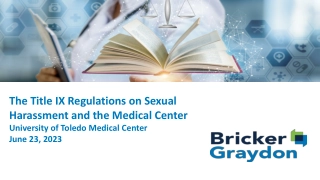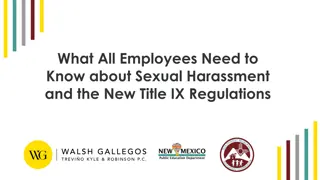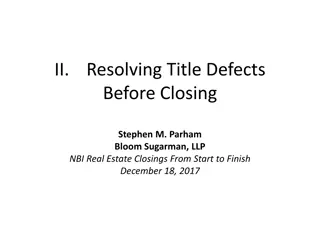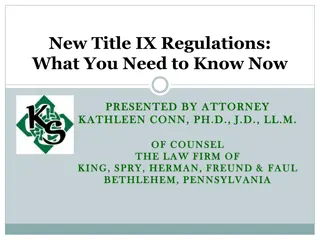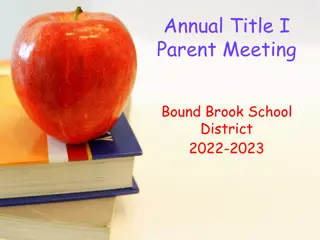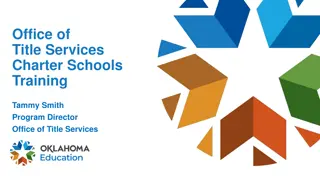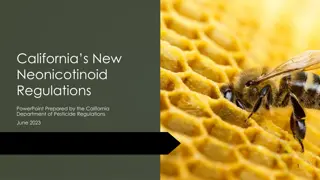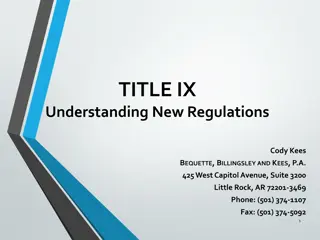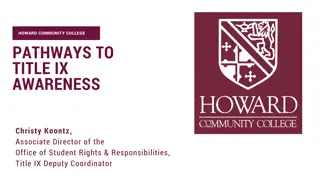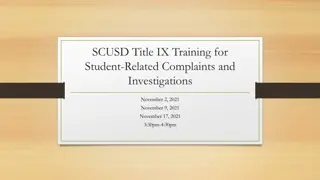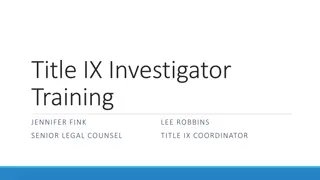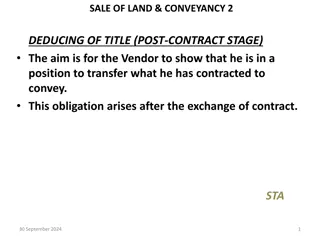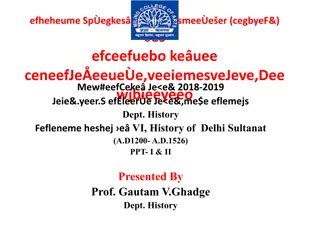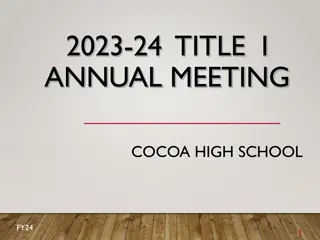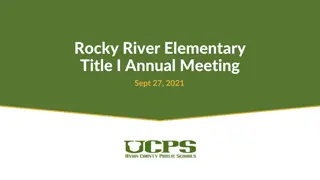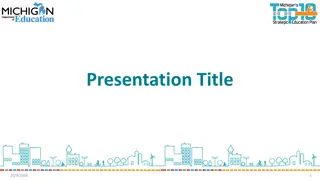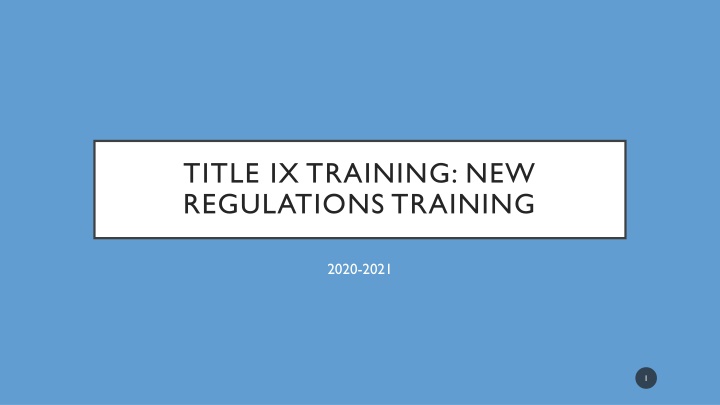
Understanding Title IX Training Regulations 2020-2021
The provided content outlines the Title IX training regulations for 2020-2021, emphasizing key points such as the prohibition of sex-based discrimination in educational programs, the impact of the 2020 Title IX regulations, reporting processes, and the higher standard required for Title IX sexual harassment cases. It also highlights the roles of the legal department and the responsibilities of all school employees in ensuring compliance with Title IX.
Download Presentation

Please find below an Image/Link to download the presentation.
The content on the website is provided AS IS for your information and personal use only. It may not be sold, licensed, or shared on other websites without obtaining consent from the author. If you encounter any issues during the download, it is possible that the publisher has removed the file from their server.
You are allowed to download the files provided on this website for personal or commercial use, subject to the condition that they are used lawfully. All files are the property of their respective owners.
The content on the website is provided AS IS for your information and personal use only. It may not be sold, licensed, or shared on other websites without obtaining consent from the author.
E N D
Presentation Transcript
TITLE IX TRAINING: NEW REGULATIONS TRAINING 2020-2021 1
CONTACT: LEGAL DEPARTMENT Stephanie Davies, Associate Legal Counsel and Equity Compliance Officer sdavies@cherrycreekschools.org (720)-554-4471 Hope Griffin, Associate Legal Counsel and Equity Compliance Officer (720)-554-4415 jgriffin@cherrycreekschools.org Caitlin Holzfaster, Legal Compliance Liaison cholzfaster@cherrycreekschools.org (720) 554-4375 2
TITLE IX No person in the United States shall, on the basis of sex, be excluded from participation in, be denied the benefits of, or be subjected to discrimination under any education program or activity receiving Federal financial assistance. 3
2020 TITLE IX REGULATIONS Replace previous OCR guidance and Title IX procedures It is the Law Takes effect August 14, 2020 Are not retroactive 4
MAJOR POINTS Still about supporting students No Title IX Outcome Reports Defines sexual harassment Requires a Complainant file a Formal Complaint The burden for Title IX Sexual Harassment is much higher 5
MAJOR POINTS No discipline for Title IX sexual harassment prior to a Title IX grievance procedure Supportive measures cannot be disciplinary, punitive, or unreasonably burdensome Onerous Formal Complaint Procedure All School employees are now responsible employees 6
ANYONE CAN REPORT Parents, Guardians, Teachers, School Employees, Students Can report by mail, phone, email, or in person using the information listed for the Title IX coordinator. Report may be written or verbal 7
HIGHER STANDARD Actual knowledge, Of Title IX sexual harassment or allegation of Title IX sexual harassment, That occurred within the schools educational program or activity; and Against a person in the United States. 8
ACTUAL KNOWLEDGE A school has actual knowledge when ANY school district employee has knowledge of or receives a report of Title IX sexual harassment or allegations of Title IX sexual harassment. Failure to respond to actual knowledge = deliberate indifference(clearly unreasonable in light of the known circumstances)= School District liability. 9
SEXUAL HARASSMENT AS DISCRIMINATION Conduct on the basis of sex that satisfies one or more of the following: 1.Quid Pro Quo Sexual Harassment 2. Severe and Pervasive Sexual Harassment 3.Clery Act Sexual Harassment 10
ONLY offenses to constitute sexual harassment under Title IX 2020 Severe, pervasive, objectively offense, and denies access to educational environment. Quid pro Quo Clery Act Violations Severity of Alleged Conduct Leering Inappropriate advances Gender-focused jokes Requests for sexual favors Questions about sexual experience Sexual comments Derogatory terms Drawing obscene images Showing pornographic materials Groping Inappropriate touching Sexual Harassment: violation of CCSD Student Code of Conduct 11 Examples of Sexual Harassment
SEXUAL HARASSMENT AS DISCRIMINATION Conduct on the basis of sex that satisfies one or more of the following: 1. Quid Pro Quo Sexual Harassment: Any School District employee conditioning the provision of an aid, benefit, or service of the School District to any student's participation in sexual conduct; 2. Severe and Pervasive Sexual Harassment: Unwelcome conduct that a reasonable person would determine is so severe, pervasive AND objectively offensive that it effectively denies a person equal access to the recipient's education program or activity; 3. Clery Act Sexual Harassment : "Sexual Assault, "Dating Violence, "Domestic Violence or "Stalking as defined in the Clery Act. 12
EDUCATIONAL PROGRAM OR ACTIVITY Must occur in school educational program or activity Includes, locations, events, or circumstances over which the recipient exercised substantial control over both the Respondent and the context in which the sexual harassment occurred. If the conduct did not occur in an educational program or activity, it does not fall under Title IX sexual harassment, and any complaint must be dismissed. 13
QUID PRO QUO 1. Quid Pro Quo Sexual Harassment: Any School District employee conditioning the provision of an aid, benefit, or service of the School District to any student's participation in sexual conduct; Teacher promises a good grade to a student for sex Assistant Coach promises a student more playing time if they send a nude photo Para promises to let students into a building afterhours for sexual favors 14
1. TITLE IX SEXUAL HARASSMENT: QUID PRO QUO 2. Does the allegation involve a School District Employee? 1. Knowledge or Report of allegation to any School District Employee If involves adult address mandatory reporting. If involved student utilize student on student process. Yes No Report to HR 3. Is the allegation sexual in nature? No Complaints regarding employees should following building process. Yes 4. Does the allegation involve a promise or benefit to the student? No Address whether allegations are severe, pervasive, and objectively offense (Title IX sexual harassment) or CCSD GBEB Policy. Yes Note: Does not have to be severe and pervasive . One incident is enough. The alleged conduct constitutes an allegation of sexual harassment under Title IX. Follow the Title IX procedures. 15
SEVERE AND PERVASIVE SEXUAL HARASSMENT 2. Severe and Pervasive Sexual Harassment: Unwelcome conduct determined by a reasonable person to be so severe, pervasive AND objectively offensive that it effectively denies a person equal access to the recipient's education program or activity; 16
2. SEVERE AND PERVASIVE SEXUAL HARASSMENT 2. Investigate: Is the ALLEGATION sexual in nature or based on sex? 1. Knowledge or Report of allegation to any School District Employee Yes Not Title IX. Apply CCSD policies. School MAY discipline. 3. Investigate: Is the alleged conduct unwelcome? Yes No 4. Is the alleged conduct severe? Yes 5. Is the alleged conduct pervasive? Yes The alleged conduct constitutes an allegation of sexual harassment under Title IX. Follow the Title IX procedures. CANNOT discipline without grievance procedure. 6. Is the alleged conduct objectively offensive? Yes 7. Did the conduct deny access to the learning environment? 17 Yes.
UNWELCOME SEXUAL CONDUCT Identified by the Complainant Conduct is sexual in nature, or where conduct references one sex or another, that suffices to constitute conduct on the basis of sex without inquiring into the motive of the perpetrator. 18
SEVERE Very great, intense Takes into account the circumstances facing a particular Complainant, such as, age, disability status, sex, and other characteristics. Complainant does not have burden to prove severity , because Complainant need only describe what occurred. Title IX Coordinator must determine whether the occurrence was severe from the perspective of a reasonable person in the complainant's position. 19
PERVASIVE Spreading widely throughout; continuous, concerted, and not episodic. Does not require investigation into every comment/joke that harms and humiliates a person on the basis of sex. Dissemination of offensive material or multiple people agreeing to potentially victimize others and taking steps in furtherance of the agreement may reach pervasiveness. 20
OBJECTIVELY OFFENSIVE Evaluated in the context of the particular factual circumstances. Reasonable person standard applied and common sense approach. Regardless of intent of the Respondent. Takes into account the ages and developmental abilities of the involved parties. 21
DENIAL OF EQUAL ACCESS Student may be physically or entirely excluded; or Any situation where the sexual harassment so undermines and detracts from the victims educational experience, that the victim-students are effectively denied equal access to an institutions resources and opportunities . 22
2. SEVERE AND PERVASIVE SEXUAL HARASSMENT 1. Knowledge or Report of allegation to any School District Employee 2. Investigate: Is the ALLEGATION sexual in nature or based on sex? 3. Investigate: Is the alleged conduct unwelcome? 4. Is the alleged conduct severe? 5. Is the alleged conduct pervasive? 6. Is the alleged conduct objectively offensive? 7. Did the conduct deny access to the learning environment? 23
CLERY ACT SEXUAL HARASSMENT The act requires colleges and universities that participate in federal financial aid programs to keep and disclose information about crime on and near their respective campuses. The definitions for sexual harassment apply for all schools, including K-12. Sexual assault as defined in 20 U.S.C. 1092(f)(6)(A)(v) dating violence as defined in 34 U.S.C. 12291(a)(10) domestic violence as defined in 34 U.S.C. 12291(a)(8) stalking as defined in 34 U.S.C. 12291(a)(30). 24
3. TITLE IX SEXUAL HARASSMENT: CLERY ACT 2. Does the allegation rise to the level of "Sexual Assault, "Dating Violence, "Domestic Violence or "Stalking as defined in the Clery Act. Not Title IX. Apply CCSD policies. School MAY discipline. 1. Knowledge or Report of allegation to any School District Employee No YES The alleged conduct constitutes an allegation of sexual harassment under Title IX. Follow the Title IX procedures. CANNOT discipline without grievance procedure. Note: Does not have to be severe and pervasive . One incident is enough. 25
CLERY ACT:SEXUALASSAULT AS DEFINED IN 20 U.S.C. 1092(F)(6)(A)(V) The term sexual assault means an offense classified as a forcible or non-forcible sex offense under the uniform crime reporting system of the Federal Bureau of Investigation. 20 U.S.C. 1092(f)(6)(A)(v) Rape: The penetration, no matter how slight, of the vagina or anus with any body part or object, or oral penetration by a sex organ of another person, without the consent of the victim. Fondling: The touching of the private body parts of another person for the purpose of sexual gratification, without the consent of the victim, including instances where the victim is incapable of giving consent because of his/her age or because of his/her temporary or permanent mental incapacity. Incest: Sexual intercourse between persons who are related to each other within the degrees wherein marriage is prohibited by law. Statutory Rape: Sexual intercourse with a person who is under the statutory age of consent. A sex offense is any sexual act directed against another person, without the consent of the victim, including instances where the victim is incapable of giving consent. 26
ELEMENT OF CONSENT Is the student old enough or able to consent to sexual contact? There is no age of consent before the age of eighteen (18) in Colorado. The age of consent is also based on the age and relationship of the alleged actor engaging in sexual contact or conduct with the alleged victim. Did the Complainant identify whether they consented? C.R.S. 18-3-401.Definitions (1.5) Consent" means cooperation in act or attitude pursuant to an exercise of free will and with knowledge of the nature of the act. A current or previous relationship shall not be sufficient to constitute consent. Submission under the influence of fear shall not constitute consent. 27
CAN THE COMPLAINANT CONSENT? At the time of the commission of the act, the victim is less than fifteen (15) years of age and the actor is at least four (4) years older than the victim and is not the spouse of the victim. Example: The Complainant is 14 and the Respondent is 18. At the time of the commission of the act, the victim is at least fifteen (15) years of age but less than seventeen (17) years of age and the actor is at least ten (10) years older than the victim and is not the spouse of the victim. Example: Complainant is 15 and the Respondent is 25 years old. 28
CAN THE COMPLAINANT CONSENT The Complainant cannot consent if : The Complainant is physically helpless and the actor knows the victim is physically helpless and the Complainant has not consented. The Respondent knows that the victim is incapable of appraising the nature of the Complainant's conduct. The Complainant is physically helpless and the actor knows the Complaint is physically helpless (means unconscious, asleep, or otherwise unable to indicate willingness to act) and the victim has not consented. The Respondent has substantially impaired the Complainant's power to appraise or control the Complainants' conduct by employing, without the Complainant s consent, any drug, intoxicant, or other means for the purpose of causing submission The Complainant s is in custody of law or detained in a hospital or other institution and the actor has supervisory or disciplinary authority over the Complainant and uses this position of authority, unless incident to a lawful search, to coerce the Complainant to submit. 29
CLERY ACT: Domestic Violence as defined in 34 U.S.C. 12291(a)(8) (8)DOMESTICVIOLENCE: Felony or misdemeanor crimes of violence committed by a current or former spouse or intimate partner of the victim, by a person with whom the victim shares a child in common, by a person who is cohabitating with or has cohabitated with the victim as a spouse or intimate partner, by a person similarly situated to a spouse of the victim under the domestic or family violence laws of the jurisdiction receiving grant monies, or by any other person against an adult or youth victim who is protected from that person s acts under the domestic or family violence laws of the jurisdiction. 34 U.S.C. 12291(a)(8) 30
CLERY ACT: DATING VIOLENCE AS DEFINED IN 34 U.S.C. 12291(A)(10) (10)DATINGVIOLENCE The term dating violence means violence committed by a person (A)who is or has been in a social relationship of a romantic or intimate nature with the victim; and (B)where the existence of such a relationship shall be determined based on consideration of the following factors: (i)The length of the relationship. (ii)The type of relationship. (iii)The frequency of interaction between the persons involved in the relationship. a 31
CLERY ACT: STALKING AS DEFINED IN 34 U.S.C. 12291(A)(30) (30)STALKING The term stalking means engaging in a course of conduct directed at a specific person that would cause a reasonable person to (A)fear for his or her safety or the safety of others; or (B)suffer substantial emotional distress. 32
MANDATORY REPORTING VS. TITLE IX SEXUAL HARASSMENT EXAMPLE Mandatory Reporting : Must be reported to Law Enforcement or the Department of Human Services Title IX Sexual Harassment: Must be reported to Title IX Coordinator Middle School Student alleges on multiple occasions a student requested sexual favors, and threatened to hurt her if she did not give into his requests. Student alleges a Coach promised them more playing time if they sent them sexual messages. (Quid Pro Quo) Yes: The threat should be reported to law enforcement. Yes: This may constitute Title IX sexual harassment and should be reported to the Title IX Coordinator. Yes: This should be reported to Law Enforcement. Yes: This may constitute Title IX sexual harassment and should be reported to the Title IX Coordinator. Student alleges a Parent touches them sexually. Yes: This should be reported to the Department of Human Services and Law Enforcement. No: This does not fall under Title IX sexual harassment. 33
SEXUAL HARASSMENT PROCESS Student on Student School Employee on Student Clery Act Severe and Pervasive Sexual Harassment Clery Act Quid Pro Quo Severe and Pervasive Sexual Harassment Report to Title IX Coordinator and Mandatory Reporting Report to HR, Title IX Coordinator, and Mandatory Reporting Supportive Measures for Student Supportive Measures for Student Title IX Grievance Procedure Title IX Grievance Procedures: HR involved 34
PARTIES: COMPLAINANT Complainant means an individual who is alleged to be the victim of conduct that could constitute sexual harassment. Could be any student regardless of gender, race, age, religion, national origin, sexual orientation, transgender status C Right to Supportive Measures regardless of whether files a Formal Complaint Right to be informed of how to file a Formal Complaint Right to decline to file a Formal complaint or decline to participate in Grievance Procedures 35
PARTIES: RESPONDENT Student alleged to be responsible for the sexual harassment Could be any student regardless of gender, race, age, religion, national origin, sexual orientation, transgender status R Right to be presumed non-responsible for the alleged conduct Right to not have supportive measures be unreasonably burdensome, disciplinary, or punitive 36
CONFIDENTIALITY The School must keep confidential the identity of any individual who: Made a report or complaint of sex discrimination Made a report or filed a formal complaint of sexual harassment Any complaint Any individual who has been reported to be the perpetrator of sex discrimination Any respondent And any witness, except as may be permitted under FERPA 20 U.S.C. 1232g, or the implementing regulations, 34 CFR part 99, or as required by law. 37
SCHOOL TEAM Reporters Title IX Coordinator(s) Investigator(s) Decision Maker Informal Resolution Remedy Support(s) Appeals Advisors 38
TITLE IX COORDINATOR RESPONSE 1. Title IX Coordinator will promptly contact the Complainant to discuss the availability of Supportive Measures; 2. Consider the Complainant s wishes with respect to supportive measures; 3. Inform the Complainant of the availability of supportive measures with or without the filing of a Formal Complaint; 4. And explain the process for filing a Formal Complaint. The Title IX Coordinator will also explain any supportive measures will be kept confidential, provided maintaining confidentiality would not impair the ability of the School to provide supportive measures. 39
SUPPORTIVE MEASURES Non-disciplinary, non-punitive individualized services offered as appropriate offered to the complainant or the respondent before or after the filing of a formal complaint or where no formal complaint has been filed. Designed to restore or preserve equal access to the recipient s education program or activity without unreasonably burdening the other party. The School must maintain as confidential any supportive measures provided to the complainant or respondent, to the extent that maintaining such confidentiality would not impair the ability of the School to provide the supportive measures. 40
SUPPORTIVE MEASURES MAY INCLUDE: Mental Health or Check-Ins Extensions of deadlines or other course-related adjustments Modifications of work or class schedules Campus escort services or para escort for Complainant Mutual restrictions on contact between the parties (no contact- contracts) Leaves of absence Increased security and monitoring of certain areas of the School Cannot be disciplinary, punitive, or unreasonably burdensome on the Respondent. 41
EMERGENCY REMOVAL 106.44 If there is an immediate threat to a person s physical health or safety arising from the allegations of sexual harassment a Respondent may be removed from educational opportunities and benefits. 42
EMERGENCY REMOVAL 106.44 Requires individualized safety risk or safety analysis School must determine: 1. An immediate threat exists 2. The threat justifies removal Cannot be speculative May be determined through a Suicide risk assessment/SEIS or Threat Assessment process 43
AFTER EMERGENCY REMOVAL 106.44 Respondent must be provided notice and opportunity to contest removal Notice does not need to be in writing Opportunity to contest removal does not have to be formal hearing process Respondent must show that the removal decision was incorrect. Emergency removal cannot be indefinite without use of Grievance Procedure 44
Title IX Grievance Procedure Allegation of Title IX sexual harassment reported to ANY School District Employee Report to Building Title IX Coordinator Emergency Removal? Supportive Measures Complainant/Parent/Guardian declines to sign a Formal Complaint Complainant/Parent/Guardian decides to file a Formal Complaint Title IX Formal Complaint Procedure Informal Resolution can occur any time with written agreement of both parties after a formal complaint and prior to a finding of responsibility. Not applicable for Employee Respondents. Title IX Coordinator decides to proceed with signed Formal Complaint Title IX Coordinator Agrees to Supportive Measures Only Complaint not dismissed Notice Investigation Resolution/ Decision 45 Appeal
GRIEVANCE PROCEDURE Very onerous Please reach out for support Will have forms to guide School teams through the process Replaces all other previous Title IX procedures 46
GRIEVANCE PROCEDURE Complainant must be provided with information of how to file a Formal Grievance. Information must include that the Complainant has the option to NOT file a grievance or participate in grievance procedures. Complainant receive Supportive Measures regardless of choice. 47
COMPLAINANT DECLINES TO FILE A FORMAL GRIEVANCE Complainant is always entitled to any Supportive Measures Where the Title IX Coordinator signs a formal complaint, the Title IX Coordinator is not a complainant or otherwise a party. Title IX Coordinator chooses to accept or deny a Complaint 48
FORMAL COMPLAINT FILED Formal complaint means a document filed by a complainant or signed by the Title IX Coordinator alleging sexual harassment against a respondent and requesting that the recipient investigate the allegation of sexual harassment. Document filed by a complainant means a document or electronic submission that contains the complainant s physical or digital signature, or otherwise indicates that the complainant is the person filing the formal complaint. 49
DISMISSAL OF FORMAL COMPLAINT Must Dismiss if: Would not constitute Title IX sexual harassment or as is defined in the regulations. Did not occur in a School District education program or activity. Did not occur against a person in the U.S. May Dismiss if: Complainant notifies the Title IX Coordinator in writing that the Complainant would like to withdraw formal complaint or allegations. Respondent is no longer enrolled or employed by the School District. Specific circumstances prevent the School District from gathering evidence sufficient to reach a determination. Upon Dismissal of a Formal Complaint, the School District will provide written notice of the dismissal and the reason(s) for the dismissal to the Complainant and the Respondent, simultaneously. 50

